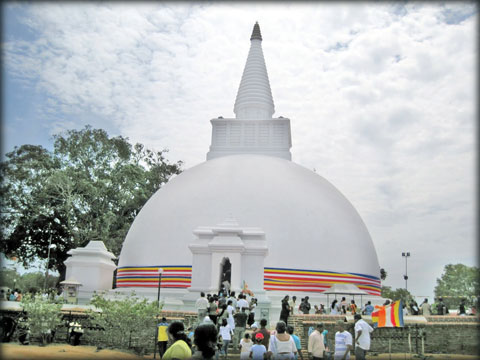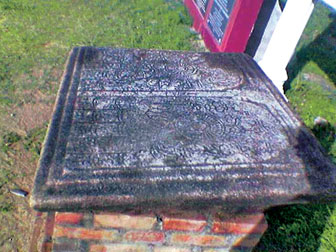Miracles of Somawathie dagoba attract pilgrims
 It was May 09, 2010 and the devotees at the Somawathie shrine were
attending a Kiripindu Pooja. Minutes and hours passed by, and all were
engrossed in the pooja, when a strange pinkish light appeared near the
square chamber of the Pagoda. The air above the premises echoed by the
hum of a worship, 'sadhu!'It was not an alien incident for Somawathiya;
it had happened numerous times before. Some scholars interpret this
light as illuminations of the Buddha and some deem this as a proof for
the appearance of a god. Whatever it is, these miracles do bring many
devotees to the shrine. It was May 09, 2010 and the devotees at the Somawathie shrine were
attending a Kiripindu Pooja. Minutes and hours passed by, and all were
engrossed in the pooja, when a strange pinkish light appeared near the
square chamber of the Pagoda. The air above the premises echoed by the
hum of a worship, 'sadhu!'It was not an alien incident for Somawathiya;
it had happened numerous times before. Some scholars interpret this
light as illuminations of the Buddha and some deem this as a proof for
the appearance of a god. Whatever it is, these miracles do bring many
devotees to the shrine.
Around 40 kilometres away from Polonnaruwa, the Somawathie Chethiya
is a popular pilgrimage site among the Buddhists and non-Buddhists. The
place creates a lot of news throughout the year. Besides, the miracles,
there is also an elephant that visits the temple regularly to pay homage
to the Stupa which is enshrined with the right canine Tooth Relic of the
Buddha. During the rainy season, the whole area goes under water.
 During the conflict, the journey to the temple was not easy. Once you
drove in at the last army camp, you were required to leave your National
Identity Card with the security. Subsequently, it was a journey through
the thick jungle up to Somawathie Viharaya. During the conflict, the journey to the temple was not easy. Once you
drove in at the last army camp, you were required to leave your National
Identity Card with the security. Subsequently, it was a journey through
the thick jungle up to Somawathie Viharaya.
While standing here at the temple premises, I remember a story
related to my grandmother. Some years ago, my granny went missing. A few
days later, she was back at home from an adventurous journey to
Somawathiya. "I was late by the time I reached the army camp. There were
hardly any vehicles to commute up to the temple. Taking a tractor was
the only option I had. I got into it to reach the shrine and spent the
night all alone at the temple," she said. This incident took place in
2007 and she was 68 years old then.
The history of Somawathiya predate Dutugemunu. Therefore, it is much
older than Ruwanweliseya, Mirisawetiya or Jetawanaramaya. Some believe
that it was built during the reign of king Kavantissa, Dutugemunu's
father who ruled Magama. According to ancient chronicles, the very first
Arahant of the country, Aritta Thera, had visited the residence of gods
especially to bring the Sacred Right Tooth Relic of the Buddha.
As the legend unfolds, Kawantissa's sister, Somawathie Devi, had
built the dagoba during the second century BC. The Mahawamsa describes
that the royal couple who had left Ruhuna had sought refuge in Raja Rata
over a disagreement with king Dutugemunu who was also the nephew of
Somawathie. Queen Somawathie had a yearning to build a stupa in honour
of the Buddha. The king himself had agreed to the idea with much
enthusiasm. Giri Abhaya, the husband of queen Somawathie, had explored a
possible site for the construction. In the course of his survey, he came
upon an area where Bhikkhus led by Arahant Mahinda resided. When the
king suggested his idea to Arahant Mahinda, he gave his consent to the
stupa-building project.
The location was known as Somapura. There were companion stupas known
as Kumbanacchaduwa (identified as the place where Kadol elephant had
died).
The pilgrim of earlier days to the holy shrine had an opportunity to
see on one side of the dagoba, a trench-like opening revealing some five
feet inside the present dagoba, wherein is the ancient brick masonry of
the earlier dagoba. However, now the trench has been covered.
 |
|
The flooded premises |
The present freshly painted white dagoba is an enlargement of an
earlier one. Two kings have renovated the chetiya and with the opening
visitors could view the section of the chetiya that revealed the three
layers illustrating the three periods during which renovations were
undertaken.
According to scholars, some Brahmi characters found at the site have
been identified as letters from the second century. Seven stone
inscriptions detailing the history of the dagoba have also been found in
the area. Separate inscriptions found here refer to the Rebavehera and
Pajini Naka Araba Vihara, which are presumed to be the ancient names of
the monument. According to the latter, there is also a belief that the
vihara was a construction by Naka, the son of king Mahallaka Naga in the
second century.
Like the road to Seruwila Dagoba, here too, the voyage itself offers
you an array of thick jungle and swamp as well as their inhabitants, big
and small.
In fact, the dagoba is often visited at night by elephants. Sungawila
is the last little town and border village from where you cross the
Mahaweli to travel on some 13 kilometres of unsealed road that cuts
through the Somawathie's strict natural reserve and wildlife sanctuary,
and takes you through the jungle and marshy land to the great dagoba.
As elephants encroach into the temple premises, an electric fence has
been installed there. The fence is powered by solar electricity.
Electricity is switched on in the evening from six onwards.
The Somawathie Chetiya is famous in recent history due to its
miracles, which took place in the temple. Some of the valuable ancient
ruins found in the place are found at the Polonnaruwa Museum.
 |
 |
| Miracles |
The Buddha’s foot
imprint |
|

